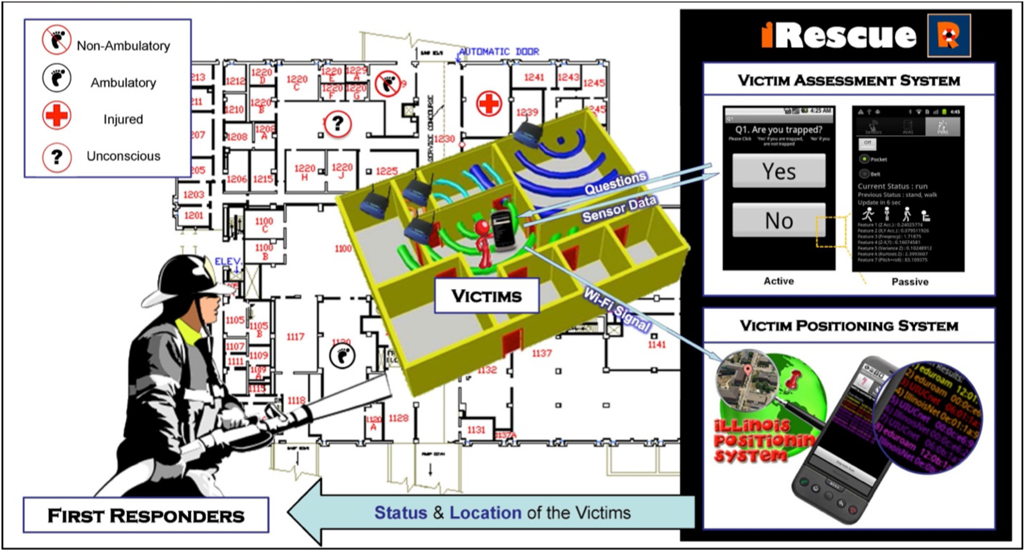EAGER PROJECT
BIO-INSPIRED
EMERGENCY
RESPONSE
This is a cross-disciplinary project that draws inspiration from biological systems to help design wireless sensing and communications networks to aid emergency responders in rescuing victims after a disaster. The project is supported by an NSF EAGER (EArly-concept Grants for Exploratory Research) award, which is targeted at exploratory research to test out new ideas and approaches.
The project is currently focused on how to quickly and efficiently get useful information to first responders about the status and location of individuals trapped inside a building. In general, first-responders have no way of sensing the presence of trapped individuals. But today, even in poorer countries, almost everybody carries a cell phone. Cell phones are getting more sophisticated every year, with dozens of onboard sensors (camera, microphone, GPS, gyroscope, accelerometer, etc.) and support for multiple wireless communications protocols (cellular, Wi-Fi, Bluetooth). Our idea is to use individual smartphones inside a building as a distributed wireless sensing network. We have been developing a prototype system called iRescue, short for Illinois Rescue:
- Following a disaster, a smartphone application could be launched automatically
to assess the status of a user via on-screen questions. We have also developed
an application that automatically uses the smartphone’s sensor data to assess
the likely status of its owner. Using accelerometer and gyroscope sensors,
which act much like an animal’s vestibular system, the smartphone can monitor
its own motion and determine what may be happening. Using a Bayesian classifier
system, which is similar to how the brain processes noisy and uncertain sensory
data, we successfully recognized nine different activity patterns (e.g., sitting,
standing, walking, running, etc.) with 90% accuracy. The system can also distinguish
between a cell phone on a desk or in a drawer from one that is being carried by
an individual.
- We are currently working on an indoor localization system that can
estimate each smartphone’s location in the absence of GPS signals that don’t
penetrate into the building . Status and location information from individual
smartphones could then be communicated wirelessly to a tablet-like device
carried by first responders, providing them with an overview of the current
situation. So far, we have implemented the basic functionalities of this
localization system for Android devices. We have also performed several test
cases to evaluate the accuracy and efficiency of our developed algorithm. The
results show that we can improve the performance and accuracy of the system
by revising the algorithm used. We are now in need of 2 programmers to help us
with the following tasks:
- Android Programmer: Our main prototyping
platform is Android. Current version of the Android application is based
on the older algorithm. The algorithm has to be updated in
addition to re-organizing the existing code and improving the UI.
Furthermore, the application currently relies on its local database for both
storing and retrieving fingerprinting data. This has to be replaced by
accessing a database stored at a server. JSON seems to be a good candidate
for communication. In addition, since Internet connection on the cellphone
might not be reliable, caching of the most
relevant fingerprinting data on the phone is also important. The developer
should expect to spend some time evaluating the performance of the developed
algorithm and code on a test area.
- Server Programmer: Our implemented system
is currently an Android application and all the fingerprinting data is
stored locally on the device. Obviously, this requires manual transfer of
the fingerprinting data from cellphone to cellphone. This worked for our
initial prototyping but is not practical in case of a large scale
experiment. We need a server programmer to develop a server side
version of the algorithm which can hold the large fingerprinting
database required for the localization algorithm. Users should be able to
easily fingerprint the area and send the fingerprint data to the server.
Server should process those recordings, integrate them with the previous
recorded data and store them in its database. Later, when the users want to
localize, they scan the area, send the list of the scanned WiFi access-points to
the server. The server should then use the previous recorded data and the
developed algorithm to find the user location. Server should notify the end
user about the calculated location inside the building. We are relatively
flexible with the server technology to be used but PHP+JSON seems like a
good candidate. The developer should expect to spend some time evaluating the
performance of the server in a few test cases under different request loads.
if you are interested in getting involved with this project, please contact me at sshifte2@illinois.edu

|



















